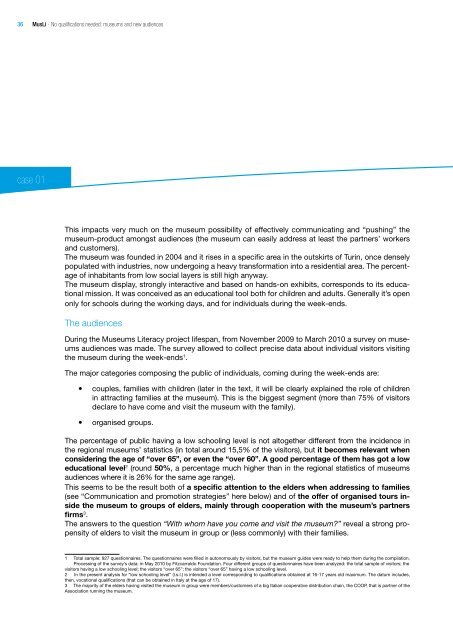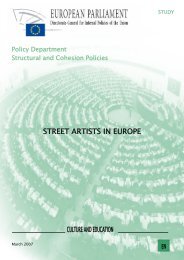MusLi (Museums Literacy) - Fondazione Fitzcarraldo
MusLi (Museums Literacy) - Fondazione Fitzcarraldo
MusLi (Museums Literacy) - Fondazione Fitzcarraldo
Create successful ePaper yourself
Turn your PDF publications into a flip-book with our unique Google optimized e-Paper software.
36 <strong>MusLi</strong> - No qualifications needed: museums and new audiences<br />
case 01<br />
This impacts very much on the museum possibility of effectively communicating and “pushing” the<br />
museum-product amongst audiences (the museum can easily address at least the partners’ workers<br />
and customers).<br />
The museum was founded in 2004 and it rises in a specific area in the outskirts of Turin, once densely<br />
populated with industries, now undergoing a heavy transformation into a residential area. The percentage<br />
of inhabitants from low social layers is still high anyway.<br />
The museum display, strongly interactive and based on hands-on exhibits, corresponds to its educational<br />
mission. It was conceived as an educational tool both for children and adults. Generally it’s open<br />
only for schools during the working days, and for individuals during the week-ends.<br />
The audiences<br />
During the <strong>Museums</strong> <strong>Literacy</strong> project lifespan, from November 2009 to March 2010 a survey on museums<br />
audiences was made. The survey allowed to collect precise data about individual visitors visiting<br />
the museum during the week-ends 1 .<br />
The major categories composing the public of individuals, coming during the week-ends are:<br />
•<br />
•<br />
couples, families with children (later in the text, it will be clearly explained the role of children<br />
in attracting families at the museum). This is the biggest segment (more than 75% of visitors<br />
declare to have come and visit the museum with the family).<br />
organised groups.<br />
The percentage of public having a low schooling level is not altogether different from the incidence in<br />
the regional museums’ statistics (in total around 15,5% of the visitors), but it becomes relevant when<br />
considering the age of “over 65”, or even the “over 60”. A good percentage of them has got a low<br />
educational level 2 (round 50%, a percentage much higher than in the regional statistics of museums<br />
audiences where it is 26% for the same age range).<br />
This seems to be the result both of a specific attention to the elders when addressing to families<br />
(see “Communication and promotion strategies” here below) and of the offer of organised tours inside<br />
the museum to groups of elders, mainly through cooperation with the museum’s partners<br />
firms 3 .<br />
The answers to the question “With whom have you come and visit the museum?” reveal a strong propensity<br />
of elders to visit the museum in group or (less commonly) with their families.<br />
1 Total sample: 927 questionnaires. The questionnaires were filled in autonomously by visitors, but the museum guides were ready to help them during the compilation.<br />
Processing of the survey’s data: in May 2010 by <strong>Fitzcarraldo</strong> Foundation. Four different groups of questionnaires have been analyzed: the total sample of visitors; the<br />
visitors having a low schooling level; the visitors “over 65”; the visitors “over 65” having a low schooling level.<br />
2 In the present analysis for “low schooling level” (l.s.l.) is intended a level corresponding to qualifications obtained at 16-17 years old maximum. The datum includes,<br />
then, vocational qualifications (that can be obtained in Italy at the age of 17).<br />
3 The majority of the elders having visited the museum in group were members/customers of a big Italian cooperative distribution chain, the COOP, that is partner of the<br />
Association running the museum.






